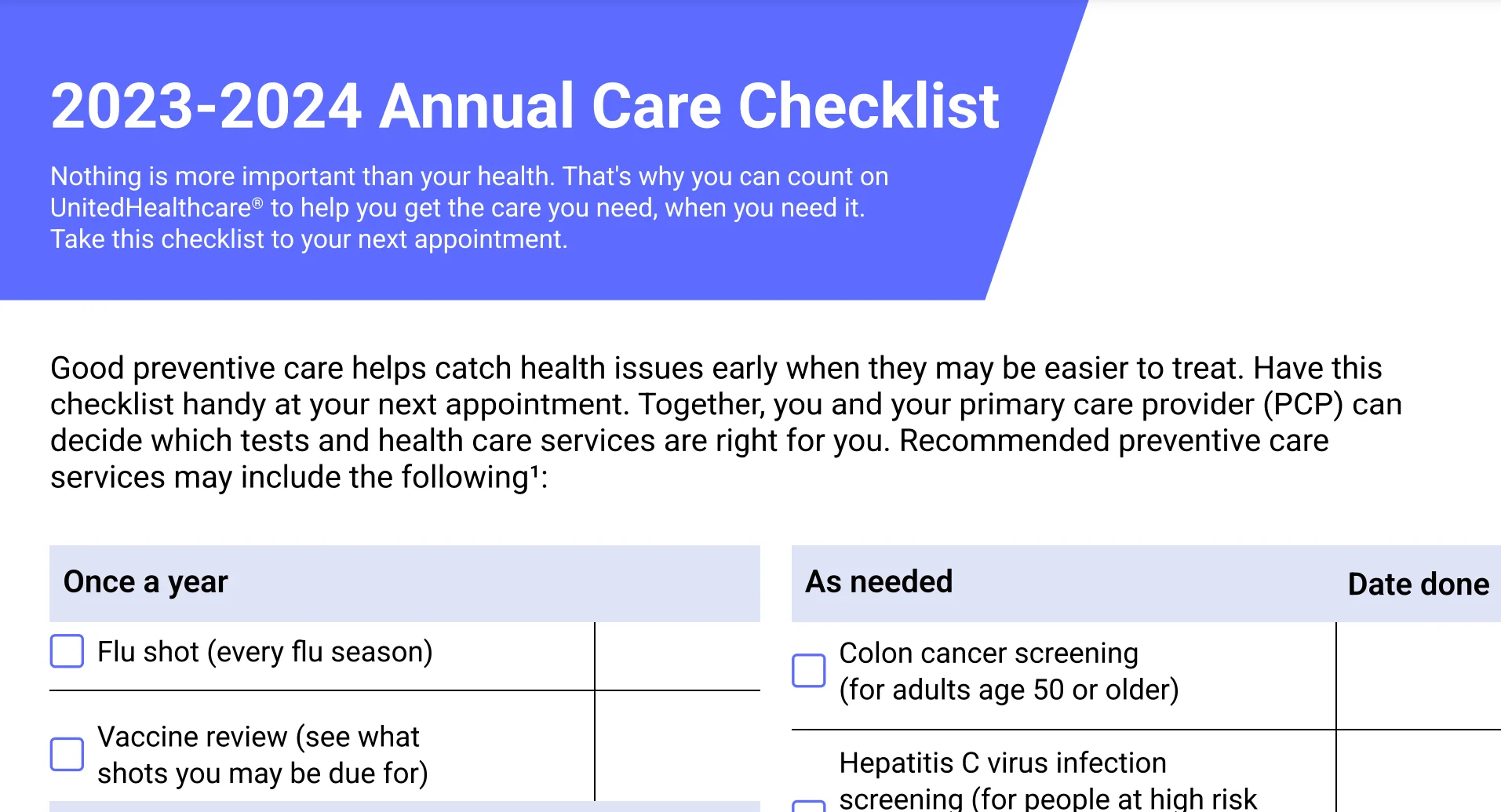UPDATED: JULY 28, 2023 | 3 MIN READ

As our annual physical exams, preventative healthcare measures like a good diet and regular exercise are essential health benefits. Consistent annual check-ups can catch many serious conditions and diseases early.
But what do these annual physical exams entail? Do they vary by gender, and more importantly, will your health insurance plan provide coverage? This article provides a detailed overview of everything to expect from your annual physical exams, from how to prepare to questions to ask your doctor.
Downloadable annual physical exam checklist

Annual physical exam preparation
Generally speaking, a baseline checklist is followed for all annual physical exams. However, depending on family history, recent medical developments, or certain ages, there is a set of routine tests and checks that your doctor will perform.
What does a physical exam entail?
Annual physical exams must be as comprehensive as possible, as they’re only performed annually. The key points of every exam should include the following:
- Medical history: Reviewing family health history, medication and past treatments, diet, and exercise habits
- Vital signs: Recording heart rate, blood pressure, body temperature, respiration rate, and blood oxygen levels and measuring them against average results as well as past results from the patient
- Blood test: Performed to help reveal any underlying health issues that may be more difficult to diagnose
- Visual exam: A physical assessment of the patient’s skin, eyes, hands, and fingernails
- Physical exam: An inspection of the patient’s body (checking the heart and lungs with a stethoscope, checking limbs and joints, and inspecting the skin for any dermatological abnormalities)
- Cancer screening: These screenings are based on factors like sex, current physical condition, and your past and family medical history.
Five questions to ask your doctor during a physical exam
An honest, open conversation with your doctor is key to a successful annual wellness exam. Before your appointment, consider asking your practitioner the following questions to make sure you have a crystal-clear understanding of the current state of your health:
- Should I make any lifestyle changes?
- Am I due for any vaccinations or COVID-19 boosters?
- Do I need any additional screenings?
- When and how will I receive my test results?
- Do I need any prescription changes?
Male annual physical exams checklist
While the main points of the checklist are the same for men and women, annual physical exams also focus on checking for prostate disease, abdominal aortic aneurysm, and heart disease.
Prostate disease
Prostate exams are included in the physical examination portion of annual exams for men. In addition to a physical examination, an ultrasound exam is also performed, a prostate-specific blood test, mid-stream urine test, and a prostate biopsy (if prostate cancer is suspected.)
Abdominal aortic aneurysm
Swelling of the abdominal section of the aorta is four times more likely to occur in men, often without specific symptoms, and can be fatal if left unchecked. These are usually diagnosed during abdominal ultrasound exams, CT scans, and MRI scans.
Heart disease
Heart disease is the leading cause of death among men and often occurs without symptoms. There are several types of heart disease, such as atherosclerotic disease, heart arrhythmia, and valvular heart disease. Each type can be diagnosed via electrocardiogram, echocardiogram, and Holter monitor.
Female annual physical exams checklist
Just like the male-specific exam, there are several diseases that more commonly affect females. Annual physical exam checklists for women include screenings for breast cancer, reproductive system disease, and autoimmune disease.
Breast cancer
Like other types of cancer, early detection of breast cancer is instrumental to successful treatment. The most common diagnostic methods include a physical breast exam, mammogram, ultrasound exam, and breast biopsy.
Reproductive system disease
Cervical cancer, endometriosis, and uterine fibroids can pose a severe health threat to women. An ultrasound exam, hysteroscopy, pap test, and colposcopy identify these conditions.
Autoimmune disease
Autoimmune diseases are often not life-threatening but still require constant monitoring. There are many autoimmune diseases, each ranging in symptoms and severity. An antinuclear antibody (ANA) test is performed when a patient is evaluated for autoimmune diseases.
Does your insurance pay for an annual physical exam?
Most insurance plans cover comprehensive wellness visits, not annual physical exams.
Comprehensive wellness visits include checking routine weight, height, and blood pressure measurements. Annual physical exams are much more extensive and include bloodwork and other tests. Check with your insurance company to confirm your benefits before you make your appointment.
How much do annual physical exams cost?
An annual physical exam’s cost will vary by coverage, doctor, and location. According to House of Debt, those without coverage may look at anywhere from $50 to $200 for an annual physical exam.
Note that this usually only involves a review of medical history and records, general physical evaluation, vitals check, and vision test. If you require a blood panel test, ultrasound, or CT scan, the costs will vary and are not included in the $50-200 price range.
Does Medicaid cover annual physical exams?
Yes, annual exams are covered by Medicaid. Also, Medicaid offers screenings for common chronic and infectious diseases and cancers, immunizations, and clinical and behavioral interventions to manage chronic diseases and reduce associated risks. Counseling to support self-management of chronic disease.
Does Medicare cover annual physical exams?
You can get an annual wellness visit if you’ve had Part B medical insurance for over a year.
During your wellness visit, your provider asks you to complete a Health Risk Assessment questionnaire for a personalized prevention plan. Your visit may also include the following:
- A review of your current providers, prescriptions, medical and family history
- Height, weight, blood pressure, and other routine measurements
- A schedule for appropriate preventive services, screenings, and shots
- Personalized health advice and advance care planning
- A list of risk factors and treatment options
- A cognitive assessment to look for signs of dementia and Alzheimer’s disease
Does private health insurance cover an annual physical exam?
This depends on your coverage plan. Many health plans may cover preventive services like your annual exam if you have an appointment with an in-network doctor. Check with your provider before making an appointment.
Importance of preventive healthcare
Preventive healthcare is crucial in maintaining overall well-being and reducing the risk of developing chronic conditions. Individuals can proactively protect and improve their health by prioritizing preventive measures alongside annual physical exams.
Value of preventive measures
By proactively adopting healthy habits and engaging in regular screenings and vaccinations, individuals can significantly reduce the risk of developing chronic conditions and detect potential health issues at early, more manageable stages. Preventive measures empower individuals to take control of their health, promoting overall well-being and enhancing the chances of a longer, healthier life. Investing in prevention today is an investment in a healthier future.
Early detection and intervention
Through regular screenings and annual physical exams, healthcare professionals can identify potential health risks, detect diseases in their early stages when they are often more treatable, and initiate timely interventions. By catching conditions early, individuals have better chances of successful treatment, improved outcomes, and a higher quality of life.
Health promotion and well-being
Beyond disease prevention, prioritizing health promotion involves adopting lifestyle habits that support physical, mental, and emotional well-being. Regular exercise, nutritious eating, stress management, and adequate sleep contribute to vitality and resilience. By embracing these practices, individuals can enhance their quality of life, boost their immune system, and cultivate a positive mindset, leading to a more balanced and fulfilling existence. Investing in health promotion and well-being is an investment in a happier, healthier life.
FAQs
What is usually included in an annual physical exam?
During an annual physical exam, your healthcare provider will assess basic vitals such as height, weight, hearing, vision, blood pressure, heart rate, and calculate your body mass index (BMI). In addition, they may examine the ears, nose, and throat. Depending on your gender, specific screenings may be performed, such as prostate exams for men and breast exams for women, to detect potential signs of cancer and ensure early detection.
What do doctors ask during a physical?
Your doctor will inquire about your medical history, current lifestyle habits, and vaccination records at the start of your physical exam. This is an ideal opportunity to discuss any health issues, concerns, or symptoms you may be experiencing. Feel free to share any ailments, discomforts, or questions you have during this time.
What is the difference between an annual physical and a wellness exam?
A physical exam plays a vital role in diagnosing and addressing health concerns. Whether you’re experiencing specific symptoms or striving to maintain good health, the exam enables your doctor to identify any issues and determine the appropriate course of action.
Additionally, a wellness exam allows your doctor to gain insights into your overall well-being, providing valuable information to support and optimize your ongoing health. By prioritizing regular physical exams, you take proactive steps toward preserving and enhancing your overall health and well-being.
Do you have to take your clothes off for an annual physical exam?
Yes, but you will be gowned. It’s best not to wear anything constrictive or hard to remove to your exam.
Should I fast before my annual physical?
Yes. It’s best to fast for 8 hours before an appointment requiring blood work.
What blood work is done yearly?
You can expect two types of blood work: a complete blood count and a metabolic panel. These tests are important for measuring electrolyte levels, liver and kidney function, hydration status, cholesterol, and blood cell values.
Should you shave before an annual physical exam?
Medical professionals understand that hair growth is natural and normal, so shaving before your exam is unnecessary.
Can I drink water before my annual physical exam?
Yes. You can drink water and black coffee if fasting before blood work.
Annual physical exams: A recap
An annual physical exam is an essential part of keeping you healthy. In addition, it’s the first step to diagnosing and treating any conditions you may have. If your health insurance doesn’t provide enough coverage for your annual wellness checkup, it’s time to get health insurance quotes from other providers.
Related Content
- What is Telehealth Services and is It the New Norm?
- Why is Health Insurance Important if You’re Young and Healthy?
- Too Young for Medicare? Consider These Health Insurance Plans
- How to Get Help With Your Medical Bills
- How to Find Low-Cost Individual Health Insurance